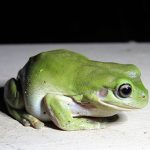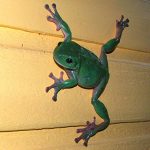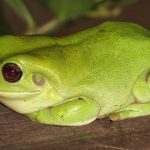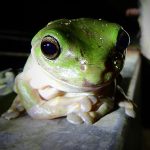GREEN TREE FROG
Green Tree Frog
On a warm, rain-washed evening in northern Australia, a broad, emerald frog settles on a lit bathroom window. Its toes press like soft suction cups against the glass, and each slow breath fogs a tiny crescent on the pane. Moths flicker towards the light; the frog waits, patient and calm, a quiet guardian of the night. Then comes the sound—low, resonant, and unhurried—a mellow “brawk… brawk… brawk” that carries through the damp air. This is the Green Tree Frog, one of Australia’s most familiar and beloved amphibians.
Identification
- A large, sturdy tree frog with a rounded head and conspicuously large toe pads for climbing.
- Skin smooth to slightly granular; older frogs often develop small white flecks on the back and flanks.
- Eyes gold to bronze with a horizontal pupil.
- Colour varies with temperature, humidity, and mood: bright green after rain, olive or brown in drier, cooler conditions.
- Males typically smaller, with a darker, sometimes wrinkled throat (vocal sac); females tend to be larger and broader.
Tip: The Green Tree Frog is much more robust than similarly coloured tree frogs. The smaller Dainty Tree Frog (Litoria gracilenta) is slimmer, with a noticeable white lip line and bright yellow on the thighs.
Quick facts
| Feature | Details |
|---|---|
| Scientific name | Litoria caerulea (often listed as Ranoidea caerulea in newer classifications) |
| Family | Pelodryadidae (Australian treefrogs) |
| Common names | Green Tree Frog, White’s Tree Frog |
| Size | Typically 7–11 cm (females larger than males) |
| Colour | Leaf-green to blue-green; can shift to olive-brown; creamy-white underside |
| Range | Northern and eastern Australia, south to around the Sydney region; also southern New Guinea |
| Habitat | Forests, woodlands, wetlands, and urban areas (homes, water tanks, bathrooms, letterboxes) |
| Status (IUCN) | Least Concern |
Range and habitat
- Widespread through northern Australia (Kimberley, Top End, Gulf Country, Cape York) and down the east coast through Queensland into New South Wales, reaching roughly the Sydney region. Also native to southern New Guinea.
- Occupies a broad range of habitats: moist forests, paperbark swamps, riparian woodlands, and human structures. In dry regions it persists around permanent water, homesteads, and irrigation points.
- Frequently seen around houses—perching in downpipes, water tanks, letterboxes, and bathrooms—where they benefit from shelter and insects attracted to lights.
Sensory snapshot: After summer rain, the air smells of wet earth and eucalyptus. From gutters and garden ponds, deep calls rise and fall slowly, like the measured pulse of the wet season.
Behaviour and diet
- Primarily nocturnal, using a sit-and-wait hunting strategy. They ambush insects, spiders, and other invertebrates, and occasionally small vertebrates.
- Excellent climbers, thanks to broad, adhesive toe pads and a strong grip.
- Often remarkably tolerant of people and unhurried in their movements, which is part of their charm.
- Skin contains bioactive compounds (defensive peptides) that help protect against microbes; these are not dangerous to people but can taste bitter to pets.
Note: Dogs or cats that mouth a Green Tree Frog may drool or vomit due to the frog’s skin secretions. This usually resolves, but consult a vet if concerned.
Voice
- The male’s advertisement call is a low, resonant series of drawn-out notes: a steady “brawk… brawk… brawk.” It’s most frequent on humid nights and after rain.
- Males call from near or just above water—gutters, fence rails, pond edges, and reeds make reliable stages.
Breeding and life cycle
- Timing follows rainfall and warmth: the wet season in the north; spring to summer after good rain further south.
- Eggs are laid in still or slow water—temporary pools, farm dams, ponds—often as floating clumps. A single clutch may contain hundreds to a few thousand eggs.
- Tadpoles are typically olive to dark brown and often school in warm shallows; development takes from several weeks to a few months depending on temperature and food.
- Metamorphs (newly transformed froglets) are tiny, bright green, and often gather on low vegetation near the water’s edge.
- Lifespan can exceed 10 years, and well-cared-for captive individuals sometimes live beyond 20 years.
Taxonomy note
- First described by John White in 1790, hence “White’s Tree Frog.”
- The species name
caeruleameans “sky-blue.” Preserved specimens lost yellow pigments and appeared blue—hence the name. Rare live frogs also show a natural blue morph when yellow pigment is reduced.
Conservation status and pressures
- Listed as Least Concern, with stable populations in many areas.
- Local threats include:
- Habitat loss and fragmentation of wetlands and tree cover.
- Disease, notably chytrid fungus (
Batrachochytrium dendrobatidis), which affects many amphibians; this species is relatively tolerant but still vulnerable in some cool, upland areas. - Road mortality and chemical exposure (pesticides, herbicides).
- Predation by feral cats and some birds.
- Poisoning risk when attempting to eat invasive Cane Toads.
The Green Tree Frog’s success around people is encouraging, but it depends on clean water, shelter, and safe urban spaces. Small choices in gardens and homes can make a big difference.
How to Help Save the Green Tree Frog
Start at home: create safe, moist refuges
- Plant native layers: grasses, shrubs, and small trees to keep humidity and provide shade. Include dense clumps and broad leaves for daytime hiding.
- Keep ground cover: mulch, leaf litter, rocks, and a few well‑placed logs or stacked bricks make cool retreats.
- Add “frog hotels”: stand short lengths of upright PVC or bamboo in a shaded pot with damp gravel. Rinse and refresh water weekly to avoid mosquitoes.
- Retain old trees where safe; frogs use smooth bark and hollows nearby for shelter.
Build a frog‑friendly pond (or improve the one you have)
- Fish‑free is best: most fish eat tadpoles. If you already have fish, use a separate, shallow pond for frogs.
- Shape matters: include gentle, shallow edges, 10–30 cm shelves, and some deeper pockets that hold water through warm spells.
- Plant natives: sedges, rushes, and water plants give cover (e.g., Baumea, Juncus, Vallisneria, Nymphaea). Leave some open water for calling.
- Use rainwater where possible; avoid copper pipes leaching into small ponds.
- Skip chemicals: no algaecides, snail pellets, or “clarifiers.” Control algae with shade, plants, and partial water changes.
- Mosquito control: screen inlets/outlets, and keep water moving gently.
Make water infrastructure safe
- Rainwater tanks: fit insect‑proof screens (≤1 mm mesh) on inlets/overflows; install a simple “frog ladder” inside and ensure overflow pipes don’t strand frogs.
- Pools and skimmers: add a floating ramp or “critter escape” step in skimmer boxes; check daily in summer.
- Yard drains and pits: fit escape ramps or rough a section so frogs can climb out.
Reduce hazards in the garden
- Minimise pesticides and herbicides; spot‑treat if you must and avoid spraying before rain.
- Never use glue traps; they catch and kill frogs and other wildlife.
- Choose warm‑colour, shielded LEDs and motion sensors outdoors. Lower, softer light reduces insect swarms and keeps frogs away from risky hard surfaces.
- Keep dogs indoors at night where possible; keep cats indoors or on a dusk‑to‑dawn curfew. Elevate pet water bowls at night so they don’t become hunting sites.
Be disease‑smart (chytrid awareness)
- Do not move frogs, tadpoles, or eggs between water bodies—this spreads disease.
- Clean and dry gear: after visiting creeks/ponds, rinse mud off boots, nets, and buckets, then disinfect (e.g., 1% household bleach for 1 minute or an amphibian‑safe disinfectant), rinse, and air‑dry.
- Handling a frog: only when necessary. Wet, clean hands or powder‑free gloves; avoid sunscreen/repellent on skin; keep the frog low, shaded, and calm; release exactly where found.
Help them share our spaces
- Bathrooms, tanks, and letterboxes are favourite shelters. If a frog turns up inside:
- Close doors to keep it contained.
- Gently guide it into a ventilated container with a soft, damp cloth.
- Release it at dusk in dense garden cover within 10–20 metres of where it entered.
- Check toilets before flushing in frog‑friendly homes—these frogs love cisterns and pipes.
Safer roads and rainy nights
- Drive slowly on warm, wet evenings—frogs often cross roads after rain.
- Advocate for wildlife‑friendly drainage with escape ramps in kerb inlets and pit traps during local road upgrades.
Support local habitat beyond your fence
- Join a Landcare, BushCare, or catchment group to restore creeklines and wetlands with native plants.
- Work with your council or school to create frog habitat—small, fish‑free ponds with interpretive signs can become outdoor classrooms.
- Encourage councils to retain mature trees and protect small wetlands—tiny sites often punch above their weight for urban biodiversity.
Cane toad awareness (in regions where toads occur)
- Learn the difference: Green Tree Frogs are smooth and bright‑eyed; Cane Toads have dry, warty skin and large parotoid glands behind the head.
- If controlling toads, follow your state’s guidelines and humane methods (check RSPCA resources). Be especially careful not to harm native frogs—when unsure, don’t act.
Citizen science: turn your ears into data
- Record calling frogs with the FrogID app (Australian Museum). Your recordings help map breeding and track changes through time.
- Share verified sightings on the Atlas of Living Australia or iNaturalist.
- Join local groups: Frogwatch (various states/territories), Queensland Frog Society, Frog and Tadpole Study Group (NSW), NT FrogWatch, WA naturalist groups.
The Green Tree Frog’s calm presence is a promise that water still beads on leaves and night air still carries rain. When we give them shade, clean water, and a safe path home, they repay us with that steady, soothing chorus—the sound of healthy country.





